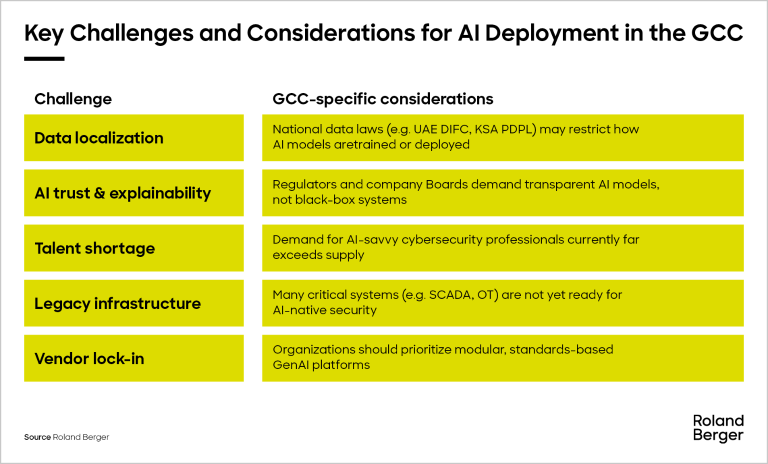Discover the true financial impact of AI projects in the Middle East. This analysis explores visible and hidden costs, regional challenges, and strategies to improve budgeting accuracy and project success rates.


Generative AI and cybersecurity
From reactive defense to strategic advantage
The countries of the Gulf Cooperation Council have stepped up their ambitions in the digital economy. This has placed cybersecurity at the top of the Board agenda in regional organizations. Visionary national programs such as the United Arab Emirates' Digital Government Strategy, Saudi Arabia's Vision 2030 and Qatar's National Cybersecurity Strategy are pushing organizations to modernize their IT infrastructure while defending against increasingly sophisticated cyberthreats. Enter generative artificial intelligence, or GenAI: a breakthrough technology that has captured the world's attention for its creative capabilities, but whose real potential lies in transforming how organizations manage cyber-risk. With its help, companies not only ensure security – they can effectively bridge the long-standing divide between cybersecurity teams and the business decision-makers.

Unlike traditional automation, GenAI doesn’t just analyze – it creates. From real-time incident summaries to predictive risk models, GenAI can support cyber-functions across a wide range of use cases:
- Threat detection & intelligence augmentation
Dynamic anomaly detection: GenAI enhances behavioral analysis by learning from vast datasets of network, endpoint and user activity.
Real-time threat briefings: It can also transform complex threat intel feeds into plain-language summaries for Chief Information Security Officers (CISOs) and executives. - Security automation & response
Automated incident response playbooks: GenAI can draft initial response steps, emails and escalation plans based on attack patterns.
Adaptive security orchestration: It can also adjust workflows based on evolving threats, reducing human error and speeding up resolution. - Vulnerability management & prioritization
GenAI can assess business context, asset value and threat likelihood, recommending which vulnerabilities to patch first. This ensures the organization focuses its resources on business-critical risks, not just technical alerts. - Cyber awareness & simulation training
Contextual phishing simulations and personalized training content generated by AI improve employee engagement and retention. Multilingual capabilities support Arabic/English environments across GCC enterprises.
"Generative AI not only strengthens cybersecurity – it firmly aligns it with business strategy."
Bridging the divide between cybersecurity and business
A common challenge in GCC organizations – especially in regulated sectors such as finance, energy and aviation – is overcoming the disconnect between cybersecurity teams and the business decision-makers. Here, GenAI builds bridges by making cyber-risks understandable, translating them into business-relevant impacts (downtime costs, data loss liability, regulatory exposure) and helping executives make faster, data-backed decisions in moments of crisis. It also enables collaborative simulations: AI-powered crisis exercises can simulate ransomware or data breach scenarios, bringing together the IT, Legal, Operations and Communications teams.
Another way that GenAI brings cybersecurity and business leaders together is by supporting compliance and policy alignment. For example, it can automatically generate or map controls to frameworks such as NCA ECC, ISO 27001 and GDPR, helping teams stay audit-ready. Furthermore, it can enhance communication with the help of AI-generated dashboards, visual summaries and email briefings, all of which service to increase transparency and reduce friction between the technical and the business units.
Regional challenges
Despite their strong digital ambitions, organizations in the GCC region must overcome a number of hurdles when it comes to the full adoption of GenAI in cybersecurity – from navigating national data regulations to avoiding the risk of vendor lock-in.
A roadmap for GCC organizations
We recommend a number of steps for enterprises and government bodies aiming to successfully implement GenAI in their cybersecurity functions:
- Pilot fast, scale smart: Start with targeted use cases such as phishing detection, log summarization or incident response drafting
- Create an AI-driven cyber-playbook: Define governance, data access, risk thresholds and explainability requirements from Day 1
- Embed "cyber" in your digital strategy: Align cyber-teams early on with your digital initiatives (e.g. cloud migration, ERP modernization), securing innovation at the core of the organization
- Invest in "human+AI" talent: Train cybersecurity professionals to collaborate with GenAI, not compete with it; create necessary roles such as AI Security Analyst and AI Risk Officer
- Partner for Impact: Collaborate with regulators, academia and industry partners to develop GCC-specific, GenAI-driven cybersecurity models
Conclusion
The GCC is uniquely positioned to play a leading role in cyber-augmented AI governance. With visionary government backing, cloud-first infrastructure and an urgency for digital trust, the region can set a global benchmark for business-aligned cybersecurity. GenAI is more than a tool – it's a strategic asset. When applied with purpose and precision, it can make cybersecurity a business enabler, not a business blocker.











